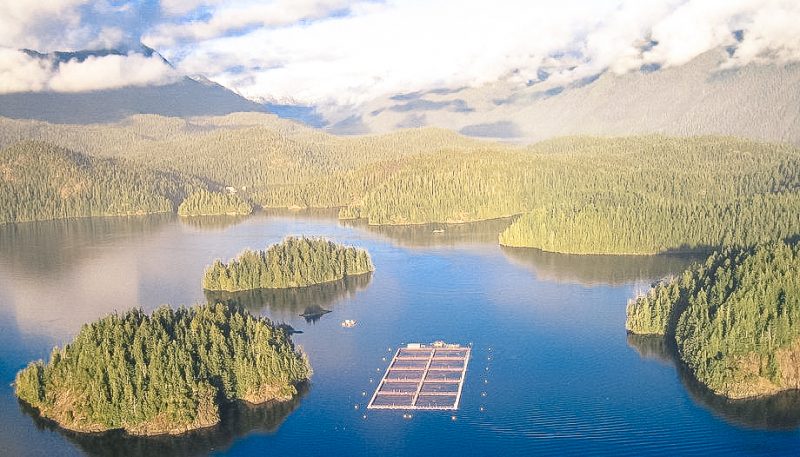Sea lice report on BC salmon farms has a surprising finding
New report by activist-scientist concedes that BC salmon farmers are managing sea lice levels well.
By Fabian Dawson
SeaWestNews
A new report aimed to show that BC salmon farmers are undercounting the amount of sea lice on their fish, has demonstrated that the numbers of the naturally occurring parasite are way below the government permitted thresholds.
However, the authors of the report, have largely kept silent on this finding, and have labelled their study ‘Bias in self‐reported parasite data from the salmon farming industry.’
It’s a technique commonly used by anti-fish farming pressure groups which have been employing questionable science and “unique” modelling to shroud their activism.
In this case, timed to pressure the Federal Government into ousting salmon farms in the Discovery Islands’ area, Sean Godwin from the Department of Biology at Dalhousie University and others analysed publicly-reported sea-louse counts from BC salmon farms between 2011 and 2016 and compared them to audited counts performed by the Department of Fisheries and Oceans.
Most of the analysis was done in 2017 as part of Goodwin’s thesis but only released this week.
The group built a new modelling method for this and claimed that industry sea-louse counts are biased downwards when DFO is not performing audits.
The industry-reported counts are therefore less likely to result in delousing treatments that are mandated by policy to safeguard wild salmon populations, their study concludes.
First off, this report appears to have taken something that is relatively simple and made it into a very complex model, that isn’t accurate.
Secondly, the study uses this self-created model and historical data, not currently available numbers, to try and estimate what sea lice counts should have been in the past. The study then reports on variances from their own model and actual sea lice counts.
Most importantly, the report clearly demonstrate that in the period studied (2011-2016) sea lice levels on salmon farms were well-managed – probably an unintended finding, but a good finding an aquaculture vet said.
“In the period studied most of the farms were below the government threshold,” Godwin, confirmed in an interview with SeaWestNews.
“But we found that industry sea-louse counts are biased downwards when DFO is not performing audits.
“We are not speculating why but hope to work with DFO and industry to figure this out,” said Goodwin.
The BC Salmon Farmers Association (BCSFA) has described the new report as “faulty” stating it doesn’t accurately represent what’s actually happening with sea lice.
“The issue is not with our sea lice counting, but with the model created for this study by its authors,” said Shawn Hall, BCSFA spokesman.
“While the study is presented as a direct comparison of sea lice data collected by salmon farmers and submitted to the DFO and audits conducted by the DFO, but that’s not actually what it does.
“Rather, the study uses a complex model the authors created themselves to try and estimate what sea lice counts should have been in the past, and are reporting on variance from their own model and actual sea lice counts. Their conclusions are based on assumptions that aren’t clear in the study,.
“What the report does do, however, is clearly demonstrate that in the period studied, sea lice levels on salmon farms were well-managed. Even if you accept the modelling numbers from their unique formula rather than the actual recorded counts, sea lice numbers were well under the regulatory threshold after which treatment is required,” said Hall.
Studies have shown that, in B.C. regardless of the presence or absence of salmon farms, there is wide variability in sea lice prevalence in coastal locations. Research over the past decade shows lice levels are significantly linked with ocean conditions and variations in wild hosts.
Salmon farm employees in B.C. are required by regulation to examine their fish every two weeks, at a minimum, for regular sea lice counts during March 1 to June 30, to coincide with ‘Out Migration’ of wild salmon.
If those counts show an average of three motile lice per fish, companies are required to take action to reduce the absolute lice count over subsequent weeks. This means either treating the fish or removing them, if a harvest is planned.
During the rest of the year, salmon farmers are required to conduct sea lice counts at least once a month.
Last month, another anti-fish farming activist group claimed hazardous levels of naturally occurring parasitic sea lice in B.C. waters this year should necessitate the shutting down of the salmon farming industry, which supports over 7,000 families in the province.
Canada’s Department of Fisheries and Oceans (DFO) responded saying: “Sea lice in British Columbia during the 2020 outmigration (March 1 to June 30) have been controlled, with no facilities violating licence conditions.”
RELATED LINK

